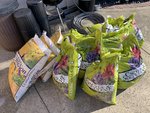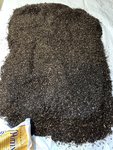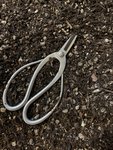“Um” , obviously, no freezing weather here… but it does show and represent its' maximum/total/possible durability and wear&tear, even for non-freezing conditions too. You don't need freezing conditions to wear and weather things. Bacterial breakdown, night & day temp shifts, humidity & dryness shifts, water weathering, friction compaction and gravity, etc. will have similar effect.
Yes, I know akadama and other specialty jdm materials breaking down, is what it’s supposed to do for finer root-ramification/development, as the fine roots actually grow inside the fissures and later crack the clay particles smaller more and more. I know Akadama and other Japanese materials also have a very good CEC (at least the raw grade ones, that aren’t super high temp fired, baked to a point of total sterility).
But, if you think about it, organic material will also allow and promote for root development and also require re-potting around the same time as akadama. So, when experts say, “bonsai will just die and roots will just rot in compacted organics/soil, organic material need repotting, so organics is very bad for bonsai” ...doesn’t the same hold true for akadama, other Japanese clay materials and other inorganic "harder" materials, that also break down and stops percolating and draining easily?
Yeah… I’m not really attracted to using granite/rock for soil-mixes. Too heavy, no water retention, no CEC.
At least organic material has very good water retention for those hot and dry climates (Southwest US area, Australia, etc.) and also very good CEC. But, yes, I understand it isn’t ideal because it turns into mush (but even some inorganics turn to mush).
That’s why I too am interested in shifting towards the “harder materials” like you mentioned… they still retain/release water, don’t turn into mush like organics, promote drainage by being a big aggregate particle in a mix and also have CEC.
My only concerns are:
Which “hard materials” and DE brands are the best and don’t turn into mush easily? ...and I'm also concerned about not using organics at all (ie: using 100% inorganic mix) in a hot hot dry climate without needing to water daily or multiple times per day.
Also another question if anyone knows:
Will DE (or a 100% inorganic mix with a lot of DE, maybe 30-50% DE) in deep/big nursery pots (5-15gal), allow me to go without watering daily? For how long, how many days, without watering will it still stay sufficiently hydrated and moist enough to keep a plant alive/healthy?
Will “100% inorganic mix with a lot of DE” allow me to water only 2-3x per week during the summer?
Hate on it as much as you like... but I love cactus-mix (at least the EB Stone brand that I use, and sometimes Kellogg)… it contains good stuff for SoCal climate - pumice, scoria lava rock, aged fir bark & redwood for its’ organic materials CEC and water retention, coarse sand for un-breakdown'able drainage particles. All in a nice consistent size (no huge woody pieces like when buying pine bark) and no powdery rock fines. It allows me to only water 2x per week too during summer (3x per week during heatwaves).






